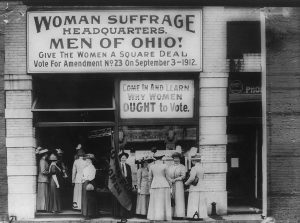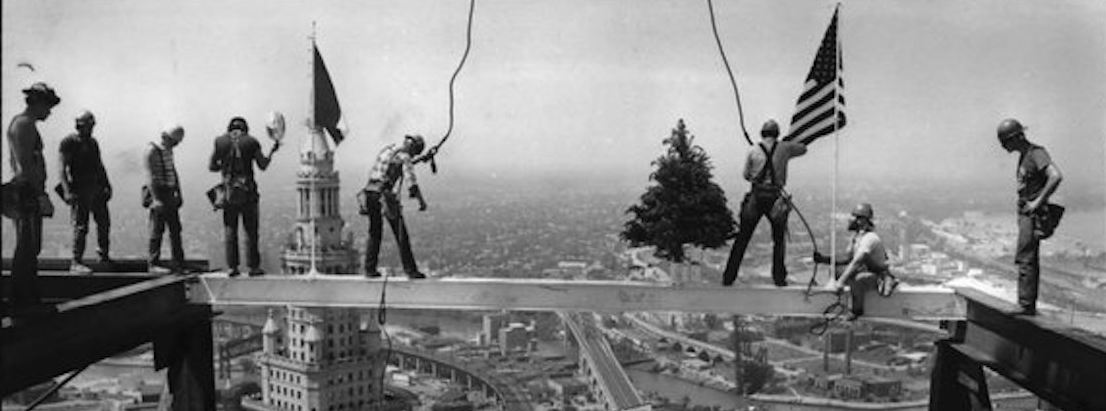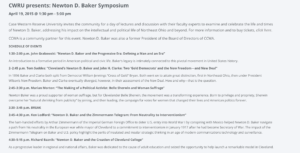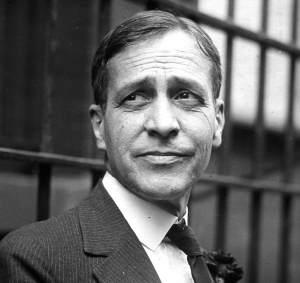
Woman Suffrage Headquarters 1912 on Euclid Avenue, Cleveland
How Cleveland Women Got the Vote – and What They Did with It
By Marian Morton
“CROWDS APPLAUD WOMEN IN PAGEANT FOR BALLOT,” cried the Cleveland Plain Dealer headlines on October 4, 1914: “Shoulder to shoulder were society leaders and women, young and old, who gain their livelihood from work in shops and offices,” marching together for an amendment to the Ohio Constitution that would enfranchise Ohio women. Photographs of the crowd – an estimated 10,000 women from 64 Ohio cities and counties and some 400 men on foot, on horseback and on an enormous float – accompanied the story. Mayor Newton D. Baker looked on proudly as his wife and two children walked alongside professional women, Hungarian and Polish women, and women in education. “Awe-Stricken cynics are silent as they View Mammoth Parade,” the newspaper claimed.[1] On that October morning, votes for Ohio women looked like a sure thing. But it wasn’t: the amendment failed. Not until 1920, did Ohio women – and all American women – get the vote with the passage of the Nineteenth (Suffrage) Amendment to the federal constitution. Nevertheless, the suffragists’ fight and final victory enlivened Cleveland politics for a quarter of a century and changed it forever.
Women suffrage was hardly a novel idea in Ohio. American women first demanded the vote at a woman’s rights convention in 1848 in Seneca Falls, New York. (The convention site is now a museum in the Seneca Falls Heritage Area.) The second and third woman’s rights conventions were held in Salem, Ohio, in 1850 and in Akron in 1851. In the post-Civil War period two suffrage organizations were founded, the American Woman Suffrage Association, established in Cleveland in 1869, and the National Woman Suffrage Association; in 1890, the two merged as the National American Woman Suffrage Association (NAWSA). From 1871 to 1876, a handful of courageous women in South Newbury, Ohio, cast their votes in state, local, and presidential elections but were rejected each time, the “judges saying that they feared trouble would be the result” if the votes were counted. [2] Woman suffrage amendments to the Ohio Constitution were defeated by the Ohio General Assembly in 1888, 1890, and 1891; in 1894, Ohio women did get the right to vote for and serve on school boards. [3]
In the next decades, women’s opportunities expanded. Growing numbers got an education; a privileged few went to college. They entered the workforce, most in industry or offices, and a handful in medicine, law, and more typically, teaching, social work, and librarianship. Women entered the public arena through the backdoor of charitable and reform activities. A good example was the Consumers League of Ohio (CLO), founded in Cleveland in 1900, the local branch of the National Consumers League. Its goal was to ensure that women and children worked under decent conditions and got paid decent wages. The league urged its members and the public to boycott shops and factories that exploited workers, but league members quickly learned that votes for women would be more effective than consumer boycotts.
In 1910, Cleveland women formally organized for suffrage, energized by seasoned suffragist Elizabeth Hauser, who was also Tom L. Johnson’s secretary and his collaborator in his autobiography My Story. CLO officers like Belle Sherwin and Marie Jenney Howe quickly joined the Cleveland Woman Suffrage Association, which launched an effort to sign up new members and elect delegates in favor of suffrage to the 1912 Ohio constitutional convention.
Sherwin was a founder and the first president the CLO. The daughter of Henry Sherwin, the founder of the Sherwin Williams Company, she graduated Phi Beta Kappa from Wellesley College, then spent a year studying history at Oxford University, before returning to Cleveland. The CLO led her into other welfare organizations, including the Public Health Nursing Association and the Federation for Charity and Philanthropy. Sherwin claimed that she had to overcome her “natural shrinking from publicity” [1] when she joined the new suffrage organization.
Cleveland men organized the Men’s Equal Suffrage League in 1911. Distinguished members included the Rev. Harris R. Cooley, Newton D. Baker, and Peter Witt, all former members of Tom L. Johnson’s cabinet, and Charles F. Thwing, president of Western Reserve University.
Women asked for the vote on the grounds that as citizens and taxpayers, they were equal to men and deserved equal rights; like the American Revolutionaries, suffragists argued that they should not be taxed unless they were represented – by themselves, not by husbands, brothers, or fathers. Suffragists also argued for the vote on the grounds that they were different from men, especially equipped by nature and nurture to clean up politics, as they might tidy up their own homes, or to use political power to care for others, as they might care for their families. Some suffragists made the first argument; some, the second, and some made both. The contradictions between the two arguments did not bother most suffragists. Newton D. Baker made an argument about simple fairness: “Democracy itself is involved in this question …. It is wrong that one-half of the people, men, should alone make the laws by which both men and women are governed.” [2]
Cleveland suffrage leaders were generally well educated, middle- and upper-class women. Their visits, luncheons, and parties were often described in the society columns of Cleveland newspapers. Their social status guaranteed that their unconventional political activities would make headlines too: “Whizz in Autos” and “Suffragists Best Anti [Suffragists] in Skirmish,” exclaimed the Cleveland Plain Dealer. [3] Yet they had political savvy enough to seek support from working women, distributing leaflets and speaking in local shops and factories and enlisting workers to march in suffrage parades.
The suffrage issue also entered local politics. In the 1911 mayoral election, Baker endorsed suffrage. His opponent, Republican Frank G. Hogen, dodged the issue, maintaining – illogically –that woman suffrage was “not intimately related to the municipal government of Cleveland.” [4]
In the 1911-1912 campaign to amend the Ohio constitution, suffragists risked public scorn and personal humiliation by speaking on soap boxes in open air venues. Forty suffragists and members of the press, including cub reporter and future editor of the Cleveland Press, Louis Seltzer, rode a private trolley through northeastern Ohio, braving shouts from the crowd that they should “stay at home.” [5] Belle Sherwin apparently overcame her natural timidity and spoke in towns throughout the region.
Suffragists collected enough signatures to ensure a referendum in 1912 that would enfranchise women by changing the words that described a voter as a “white male” to “every citizen.” Suffragists’ hopes were high: Ohio was the first state east of the Mississippi to vote on universal suffrage; “these suffragists were the first ‘nice women’ to wave flags and carry banners … the first to make soap-box speeches.” But to their sorrow, the 1912 referendum failed by 87,455 votes.[6]
And despite the splendid parade two years later, the 1914 referendum also lost – and by an even greater margin.
Suffragists blamed their defeats on well-financed “liquor interests,” who bought politicians’ support to ensure that enfranchised women would not vote saloons and distilleries out of business. Although the Cleveland suffrage organization tried to distance itself from the temperance cause, the reality was that many women – and organizations like the Women’s Christian Temperance Union – joined the suffrage movement because they did want to vote saloons and distilleries out of business. (This was accomplished in 1918 by the Nineteenth Amendment even before women got the vote.)
But the most visible opponents of woman suffrage were other women, who organized in Cleveland in 1912. Their own social status notwithstanding, suffragists described the “antis” as snobbish elitists:“ The homes along Euclid Avenue are, for the most part, strongholds of the Anti-Suffragists.” [1] Anti-suffragists maintained that most women didn’t want the vote, pointing out that few actually voted in school elections: “the duty of the vote should not be thrust upon the home-loving woman.” Moreover, giving women the vote would put power “into the hands of women agitators, women Socialists, and undesirables who want police protection.” [2] Mrs. Avery M. Elroy, president of the Cleveland Council of Women, told a group of clubwomen: “Sometime within the next hundred years women will vote. I don’t believe in being in too great a hurry …. [T]here are more important things than voting. Family happiness is one,” she maintained, and family happiness would be undermined if husband and wife disagreed about politics. [3] Not far below the surface of the anti-suffrage arguments were widely shared fears that enfranchising women would make them equal partners in marriage, leading to divorce and\or the end of the family as most Americans knew it. Some of the most progressive of Progressive reformers were not enthusiastic supporters of woman suffrage, at least not at first. Tom L. Johnson became a convert only after he was challenged by Marie Jenney Howe, the wife of Johnson’s adviser and friend, Frederic C. Howe: “”Mr. Johnson, ‘“ she asked, “’ you who are democratic in everything else, why are not you not democratic about women?’” [4] Johnson didn’t have a good answer. (In 1907, Johnson was a featured speaker at an Ohio Suffrage Association meeting in Youngstown.) [5]Howe himself confessed: ‘I spoke for woman’s suffrage without much wanting it. And I urged freedom for women without liking it.” [6]
In addition, suffragists were always short on money to combat “the wealthy Anti-Suffragists and the powerful whiskey interests;” they didn’t have jobs outside the home and didn’t want to ask their husbands for money. Consequently, they staged lively, well-publicized fund-raisers: an outdoor garden fair with interpretive dancing, a lunch kitchen, a bazaar, an elaborate suffrage pageant. [7]
Undeterred by their defeats in 1912 and 1914, Cleveland suffragists sought to disprove the opposition’s arguments that women didn’t want the vote by urging women to vote in the upcoming school board election; suffragists answered their phones “Votes for Women” instead of “Hello,” and Belle Sherwin “in the Sherwin electric [car]” made sure suffrage billboards were in place all over Cleveland. [8]
Suffragists also decided to pursue the vote at the local level. East Cleveland voters adopted a new charter that allowed women to vote in municipal elections in 1916. When the charter provision was challenged by the county Board of elections, the Cleveland Woman Suffrage League initiated a taxpayers’ suit. In April 1917, the Ohio Supreme Court decided in the league’s favor. Lakewood women got the right to vote in municipal elections shortly afterwards.
[4] Frederic C. Howe, Confessions of a Reformer. (Kent, Ohio: Kent State University Press, 1988), 137.
The lead attorney for East Cleveland suffragists was Florence E. Allen. She graduated from Women’s College (later Flora Stone Mather College) of Western Reserve University in 1904 with a degree in music. She worked for three years as a music critic for the Cleveland Plain Dealer and taught music at Laurel School before taking a graduate degree in history at Western Reserve University. Allen was refused admission to Western Reserve University’s law school but completed her law degree at New York University. While she was still in law school, she threw herself enthusiastically into the 1912 campaign in Ohio. Unlike Sherwin, Allen loved publicity, public speaking and debating anti-suffragists, reportedly making “92 speeches in 88 counties” in 1912. [1] In June, she rode the private trolley displaying “Votes for Women” on one side and “Equal Suffrage” on the other; when the trolley stopped at Kamm’s Corners, she and the other suffragists hopped off and distributed pamphlets, and Allen gave her suffrage pitch, standing on a tool box. [2]
National suffrage leaders visited Cleveland during these contests. Settlement house founder Jane Addams, labor leader Rose Schneiderman, NAWSA president Anna Howard Shaw, and Jeannette Rankin, who in 1916 became the first woman elected to Congress, gave the cause good publicity.
Across the country, the suffrage movement gained strength in 1915 and 1916 and increasingly focused on amending the federal constitution; the state-by-state amendment process, as Ohio had shown, proved too time-consuming, too expensive, and too uncertain. However, growing divisions emerged between the moderate NAWSA and the more impatient National Women’s Party and Congressional Union. Cleveland suffragists officially sided with the moderates, regardless of what individuals may have thought about militant tactics such as picketing the White House and engaging in hunger strikes in the Washington D.C. jail.
The entrance of the United States into World War I in April 1917 gave American women a chance to prove their patriotism. The NAWSA and Cleveland suffragists energetically supported the war efforts, leading food conservation drives and selling war bonds, working in factories and offices and at the Red Cross. Belle Sherwin, aided by other suffragists, headed up the Woman’s Committee of the Council of National Defense, a clearing house for women’s war work.[3]
In 1917, the Ohio Assembly passed an amendment giving Ohio women the right to vote in presidential elections. The anti-suffragists managed to get a referendum on the ballot – although the suffragists alleged voter fraud – and the amendment was repudiated by Ohio voters. But the margin of defeat was smaller than in 1912 and 1914. The tide was finally turning in favor of votes for women.
Perhaps persuaded by the NAWSA’s support for the war, President Woodrow Wilson urged Congress to pass a woman suffrage amendment. In 1919 both houses of Congress finally passed the Nineteenth Amendment, which went out to the states for ratification. Ohio became the sixth state to ratify, and the legislature simultaneously passed another presidential suffrage bill in case the national amendment did not make it through the states. Even then, the anti-suffragists challenged the suffrage amendment on the grounds that ratification of a federal amendment needed to be put to a referendum. The United States Supreme Court disagreed in June 1920.[4]
On August 18, 1920, Tennessee became the last of the states needed to ratify the Nineteenth Amendment. The amendment simply read: “The rights of citizens of the United States to vote shall not be denied or abridged by the United States or any state on account of sex.” Twenty-six million adult women got the vote, a long, weary 72 years after the Seneca Falls convention.
[1] Joan Organ, “Florence E. Allen and ‘great changes in the status of women’’, in Warren Van Tine and Michael Pierce. Builders of Ohio: A Biographical History. (Columbus: The Ohio State University Press, 2003), 222.
And so the vote was won, but the story was not over. In 1919, Carrie Chapman Catt, president of the NAWSA, sensing both imminent victory and its attendant difficulties, urged the founding of the League of Women Voters (LWV). Its goal was to educate women voters and to persuade women who had been told all their lives that they could not and should not vote, to go to the polls when they finally had the opportunity. The Cleveland League was organized in 1920. Belle Sherwin became its first president; executive board members were long-time suffragists like herself. The new non-partisan organization urged women of both parties to get into politics and did not officially endorse candidates. An exception was made for Florence Allen, who was running for the court of common pleas, a non-partisan post. National and local leagues supported passage of the federal Sheppard-Towner Maternity and Infancy Act, which became law in 1921, and passage of a federal amendment barring child labor, which did not.
Suffrage leaders, some of whom were long-time pacifists, had swallowed their distaste for global warfare when the United States entered World War I, but when the war was over and its disastrous toll was tallied up, their interest in world peace re-emerged. The national LWV, meeting in Cleveland in 1921, voted to support world disarmament.
With the support of Belle Sherwin and the Cleveland LWV, Cleveland women formed the Women’s Council on the Prevention of War; Florence Allen, who had already been elected to the Ohio Supreme Court, was its honorary chair. In 1924, a decade after they made headlines by marching for the vote, some 3500 women, and some brave men, took to the streets again, this time advocating world peace. No cheering crowds greeted them this time. “PEACE PARADE DEFIES RAIN AND CRITICS. WOMEN OF ALL CREEDS TRUDGE STREETS LINED BY SILENT THOUSANDS, said the Cleveland Plain Dealer. Many women’s organizations were represented in the parade, including the LWV, the YWCA, and the Women’s City Club. Caught in the country’s first “red scare,” marchers were accused of being the dupes of international communism. [1]
Despite these accusations, the Cleveland campaign to enfranchise and empower women almost immediately produced two national leaders. Belle Sherwin, the timid suffragist of 1910, served as president of the national League of Women Voters from 1924 to 1934. When she retired from this position, she was appointed by President Franklin D. Roosevelt to the Consumers Advisory Board of the National Recovery Administration and then to the Federal Advisory Council of the U.S. Employment Service. Florence Allen, who won her first political victory for the women of East Cleveland, became the first woman elected to a common pleas court in 1920, the first elected as an Ohio Supreme Court Judge in 1922 and 1928, the first to be appointed to a federal court, the U.S. 6th Circuit Court of Appeals in 1934, and in 1958, the first to be appointed the chief judge of any federal court, the 6th Circuit. [2] Her decision upholding the constitutionality of the Tennessee Valley Authority was affirmed by the U.S. Supreme Court in 1939.
Through the 1920s and 1930s, the Cleveland LWV continued to champion the cause of good government and citizen participation, endorsing issues such as a minimum wage for women workers, the city manager form of government, proportional representation in local elections, and fighting an on-going battle to keep women going to the polls. Although millions of American women did not exercise their right to the franchise in the 1920 presidential election, today the percentage of eligible women who vote exceeds that of men. The LWV now plays the same non-partisan educational role it did in 1920, sponsoring local and national political debates and supporting issues, not candidates.
And thanks to the suffragists’ parades, soap boxes, phone calls, pageants, and perseverance, innumerable Cleveland women have served as local councilpersons and mayors and representatives to the Ohio General Assembly and the U.S. Congress.












